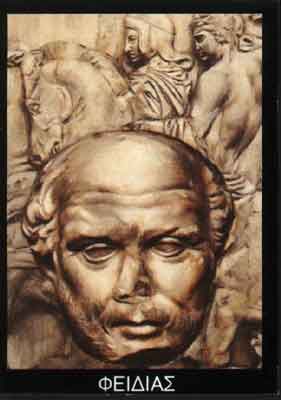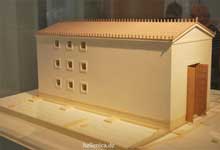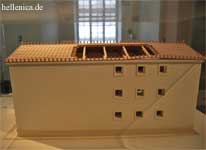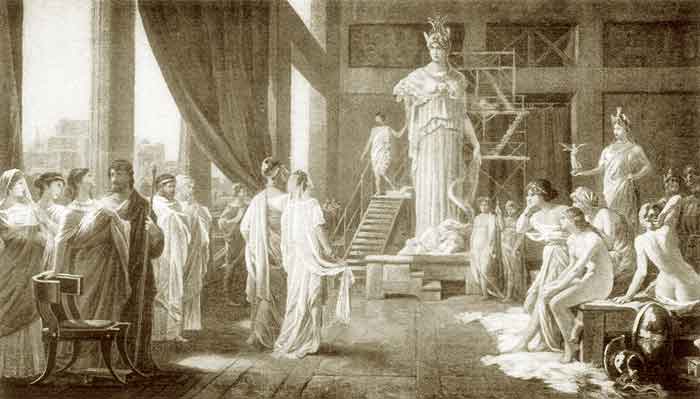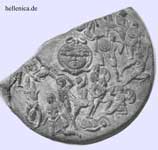.
Pheidias (or Phidias) son of Charmides, (circa 490 BC - circa 430 BC) was an ancient Greek sculptor, one of the greatest of Greek sculptors.
Pheidias designed the towering statues of the goddess Athena in the Parthenon in Athens and the colossal seated Statue of Zeus at Olympia in the 5th century BC. These works were apparently commissioned by Pericles in 447 BC.
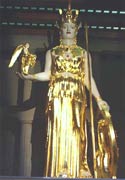
We have varying accounts of his training. Hegias of Athens, Ageladas of Argos, and the Thasian painter Polygnotus, have all been regarded as his teachers. In favour of Ageladas it may be said that the influence of the many Dorian schools is certainly to be traced in some of his work. Of his life we know little apart from his works. Of his death we have two discrepant accounts. According to Plutarch he was made an object of attack by the political enemies of Pericles, and died in prison at Athens. According to Philochorus, as quoted by a scholiast on Aristophanes, he fled to Elis, where he made the great statue of Zeus for the Eleans, and was afterwards put to death by them. For several reasons the first of these tales is preferable.
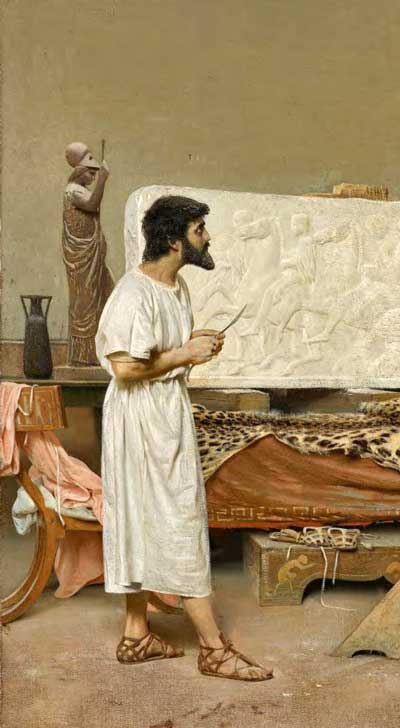
Pheidias, Raffaello Sorbi, Detail
Plutarch gives in his life of Pericles a charming account of the vast artistic activity which went on at Athens while that statesman was in power. He used for the decoration of his own city the money furnished by the Athenian allies for defence against Persia: it is very fortunate that after the time of Xerxes Persia made no deliberate attempt against Greece. "In all these works," says Plutarch, "Pheidias was the adviser and overseer of Pericles." Pheidias introduced his own portrait and that of Pericles on the shield of his Parthenos statue. And it was through Pheidias that the political enemies of Pericles struck at him. It thus abundantly appears that Pheidias was closely connected with Pericles, and a ruling spirit in the Athenian art of the period. But it is not easy to go beyond this general assertion into details.
It is important to observe that in resting the fame of Pheidias upon the sculptures of the Parthenon we proceed with little evidence. No ancient writer ascribes them to him, and he seldom, if ever, executed works in marble. What he was celebrated for in antiquity was his statues in bronze or gold and ivory. If Plutarch tells us that he superintended the great works of Pericles on the Acropolis, this phrase is very vague. On the other hand, inscriptions prove that the marble blocks intended for the pedimental statues of the Parthenon were not brought to Athens until 434 BC, which was probably after the death of Pheidias. And there is a marked contrast in style between these statues and the certain works of Pheidias. It is therefore probable that most if not all of the sculptural decoration of the Parthenon was the work of pupils of Pheidias, such as Alcamenes and Agoracritus, rather than his own.
The earliest of the great works of Pheidias were dedications in memory of Marathon, from the spoils of the victory. At Delphi he erected a great group in bronze including the figures of Apollo and Athena, several Attic heroes, and Miltiades the general. On the Acropolis of Athens he set up a colossal bronze image of Athena, which was visible far out at sea. At Pellene in Achaea, and at Plataea he made two other statues of Athena, also a statue of Aphrodite in ivory and gold for the people of Elis.
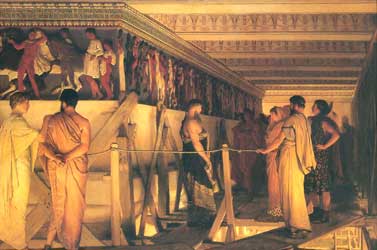
Pheidias showing the Frieze of the Parthenon to friends, 1868, Sir Lawrence Alma Tadema.
But among the Greeks themselves the two works of Pheidias which far outshone all others, and were the basis of his fame, were the colossal figures in gold and ivory of Zeus at Olympia and of Athena Parthenos at Athens, both of which belong to about the middle of the 5th century. Of the Zeus we have unfortunately lost all trace save small copies on coins of Elis, which give us but a general notion of the pose, and the character of the head. The god was seated on a throne, every part of which was used as a ground for sculptural decoration. His body was of ivory, his robe of gold. His head was of somewhat archaic type: the Otricoli mask which used to be regarded as a copy of the head of the Olympian statue is certainly more than a century later in style. Of the Athena Parthenos two small copies in marble have been found at Athens which have no excellence of workmanship, but have a certain evidential value as to the treatment of their original.
It will be seen how very small is our actual knowledge of the works of Pheidias. There are many stately figures in the Roman and other museums which clearly belong to the same school as the Parthenos; but they are copies of the Roman age, and not to be trusted in point of style. A. Furtwangler proposes to find in a statue of which the head is at Bologna, and the body at Dresden, a copy of the Lemnian Athena of Pheidias; but his arguments (Masterpieces, at the beginning) are anything but conclusive. Much more satisfactory as evidence are some 5th century torsos of Athena found at Athens. The very fine torso of Athena in the École des Beaux Arts at Paris, which has unfortunately lost its head, may perhaps best serve to help our imagination in reconstructing a Pheidian original.
Ancient critics take a very high view of the merits of Pheidias. What they especially praise is the ethos or permanent moral level of his works as compared with those of the later "pathetic" school. Demetrius calls his statues sublime, and at the same time precise. That he rode on the crest of a splendid wave of art is not to be questioned: but it is to be regretted that we have no morsel of work extant for which we can definitely hold him responsible.
In 1958 archaeologists found the workshop at Olympia where Phidias assembled the gold-and-ivory Zeus. There were still some shards of ivory at the site, and the base of a bronze drinking cup engraved "I belong to Phidias."
Pausanias
Of this marble Pheidias made a statue of Nemesis, and on the head of the goddess is a crown with deer and small images of Victory. In her left hand she holds an apple branch, in her right hand a cup on which are wrought Aethiopians
...
Having heard this legend Pheidias has represented Helen as being led to Nemesis by Leda, and he has represented Tyndareus and his children with a man Hippeus by name standing by with a horse. There are Agamemnon and Menelaus and Pyrrhus, the son of Achilles and first husband of Hermione, the daughter of Helen. Orestes was passed over because of his crime against his mother, yet Hermione stayed by his side in everything and bore him a child. Next upon the pedestal is one called Epochus and another youth; the only thing I heard about them was that they were brothers of Oenoe, from whom the parish has its name.
...
The temple and the image were made for Zeus from spoils, when Pisa was crushed in war by the Eleans, and with Pisa such of the subject peoples as conspired together with her. The image itself was wrought by Pheidias, as is testified by an inscription written under the feet of Zeus:Pheidias, son of Charmides, an Athenian, made me.The temple is in the Doric style, and the outside has columns all around it. It is built of native stone. Its height up to the pediment
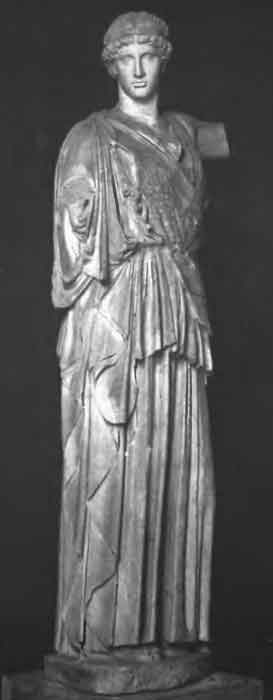
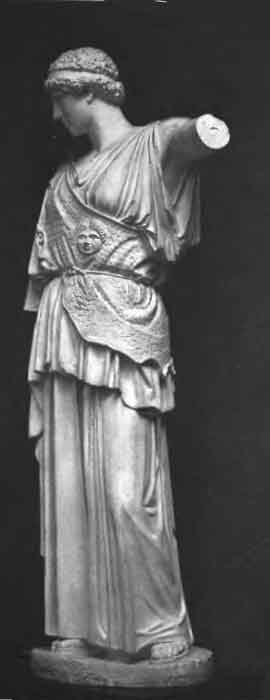
Athena Dresden with the Bologna Head reconstruction, assumed initialy an Athena Lemnia version
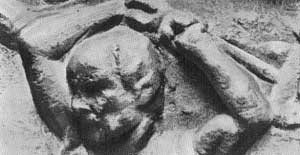
Pheidias on the Athena Parthenos Shield
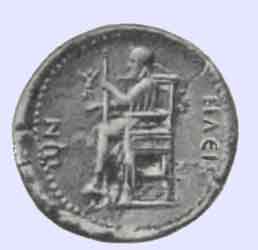
Elis Coin with Zeus Statue of Pheidias, Text "Ileion"
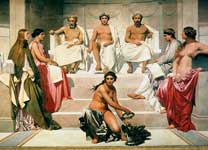
Music

Henri Christiné (1867 - 1941). Phi-Phi.
See also
The Athena Parthenos and Promachos Sculptures
The colossal Zeus Statue in Olympia
A bronze sculpture found in Bulgaria could be the work of Pheidias
Panaenus, nephew of Pheidias, Painter who helped in the decoration of the Statue of Zeus
Buy Fine Art Prints | Greeting Cards | iPhone Cases
| Ancient Greece
Science, Technology , Medicine , Warfare, , Biographies , Life , Cities/Places/Maps , Arts , Literature , Philosophy ,Olympics, Mythology , History , Images Medieval Greece / Byzantine Empire Science, Technology, Arts, , Warfare , Literature, Biographies, Icons, History Modern Greece Cities, Islands, Regions, Fauna/Flora ,Biographies , History , Warfare, Science/Technology, Literature, Music , Arts , Film/Actors , Sport , Fashion --- |
Retrieved from "http://en.wikipedia.org"
All text is available under the terms of the GNU Free Documentation License

